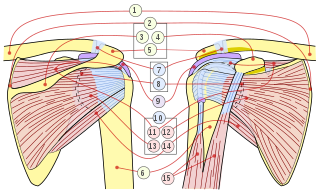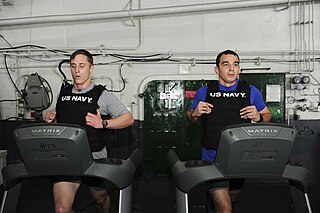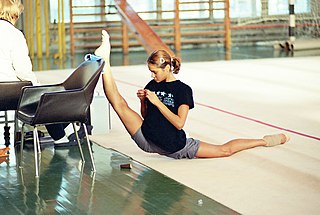
The rotator cuff is a group of muscles and their tendons that act to stabilize the human shoulder and allow for its extensive range of motion. Of the seven scapulohumeral muscles, four make up the rotator cuff. The four muscles are:

Physical fitness is a state of health and well-being and, more specifically, the ability to perform aspects of sports, occupations and daily activities. Physical fitness is generally achieved through proper nutrition, moderate-vigorous physical exercise, and sufficient rest along with a formal recovery plan.

The bench press, or chest press, is a weight training exercise where a person presses a weight upwards while lying horizontally on a weight training bench. Although the bench press is a full-body exercise, the muscles primarily used are the pectoralis major, the anterior deltoids, and the triceps, among other stabilizing muscles. A barbell is generally used to hold the weight, but a pair of dumbbells can also be used.

Strength training or resistance training involves the performance of physical exercises that are designed to improve strength and endurance. It is often associated with the lifting of weights. It can also incorporate a variety of training techniques such as bodyweight exercises, isometrics, and plyometrics.

A squat is a strength exercise in which the trainee lowers their hips from a standing position and then stands back up. During the descent, the hip and knee joints flex while the ankle joint dorsiflexes; conversely the hip and knee joints extend and the ankle joint plantarflexes when standing up. Squats also help the hip muscles.

Plyometrics, also known as jump training or plyos, are exercises in which muscles exert maximum force in short intervals of time, with the goal of increasing power (speed-strength). This training focuses on learning to move from a muscle extension to a contraction in a rapid or "explosive" manner, such as in specialized repeated jumping. Plyometrics are primarily used by athletes, especially martial artists, sprinters and high jumpers, to improve performance, and are used in the fitness field to a much lesser degree.

The lying triceps extension, also known as skull crusher and French extension or French press, is a strength exercise used in many different forms of strength training. It is one of the most stimulating exercises to the entire triceps muscle group in the upper arm, and works the triceps from the elbow all the way to the latissimus dorsi. Due to its full use of the triceps muscle group, the lying triceps extensions are used by many as part of their training regimen.
The good-morning is a weight training exercise. It is known as a good morning because of the movement in the erector spinae which resembles the bow that traditionally begins a schoolday in some East-Asian countries. The erector spinae muscles of the lower back work isometrically to keep the spine in an extended position while the hamstrings and gluteus maximus work isotonically to perform hip extension. Other muscles are involved in stabilizing weight on the back and maintaining balance.
In weight training, training to failure is repeating an exercise to the point of momentary muscular failure, i.e. the point where the neuromuscular system can no longer produce adequate force to overcome a specific workload. Two systematic reviews published in 2021 found no benefit to training to failure on hypertrophy, while one of the reviews found some evidence that not-to-failure training is superior for strength.
Complex training, also known as contrast training or post-activation potentiation training, involves the integration of strength training and plyometrics in a training system designed to improve explosive power. According to Jace Derwin:
Strength training and plyometric training are both effective measures for increasing athletic performance independent of each other, but a true program designed for power-based athletes needs to incorporate both disciplines. A study done in 2000 in the NSCA's Journal of Strength and Conditioning Research measured three different training protocols: strength training, plyometric training, and a combination of both. The group that used combined methods was the only group that showed significant increases in BOTH strength and power.

Weighted clothing are garments that have heavy materials incorporated into them, to add weight to various parts of the body, usually as part of resistance training. The effect is achieved through attaching weighted pieces to the body which leave the hands free to grasp objects. Unlike with held weights or machines, weighted clothing can leave users more able to do a variety of movements and manual labour. In some cases certain weighted clothing can be worn under normal clothing, to disguise its use to allow exercise in casual environments.

Flexibility is the anatomical range of movement in a joint or series of joints, and length in muscles that cross the joints to induce a bending movement or motion. Flexibility varies between individuals, particularly in terms of differences in muscle length of multi-joint muscles. Flexibility in some joints can be increased to a certain degree by exercise, with stretching a common exercise component to maintain or improve flexibility.

A pull-up is an upper-body strength exercise. The pull-up is a closed-chain movement where the body is suspended by the hands, gripping a bar or other implement at a distance typically wider than shoulder-width, and pulled up. As this happens, the elbows flex and the shoulders adduct and extend to bring the elbows to the torso.

The overhead press, also known as the shoulder press or military press, is an upper-body weight training exercise in which the trainee presses a weight overhead while seated or standing. It is mainly used to develop the anterior deltoid muscles of the shoulder. The standing version was once a component of the sport of Olympic weightlifting as part of the clean and press movement, but was removed in 1972 due to difficulties in judging proper technique.

A dip is an upper-body strength exercise. Close grip dips primarily train the triceps, with major synergists being the anterior deltoid, the pectoralis muscles, and the rhomboid muscles of the back. Wide shoulder width dips place additional emphasis on the pectoral muscles, similar in respect to the way a wide grip bench press would focus more on the pectorals and less on the triceps.

Dance is a healthy physical activity, with many far reaching physical, and psychological benefits. Dancing can be enjoyed in many forms, and is for every age and ability. This physical activity appeals to some who may not typically be active and therefore may be another alternative of exercise. Dance for health has become an important factor in the prevention, treatment and management in several health circumstances. It can benefit both physical and mental health and subsidizes social communication Dance is an art which is learned in and shared between many cultures. Types of dance can entail body movements, expression and collaboration. The correlation between dance and health has been subject of a number of research studies that show dance to be a largely healthy exercise. However, there are a number of health risks that require attention.
In kinesiology, core stability is a person's ability to stabilize their core. Stability, in this context, should be considered as an ability to control the position and movement of the core. Thus, if a person has greater core stability, they have a greater level of control over the position and movement of this area of their body. The body's core is frequently involved in aiding other movements of the body, such as running; thus it is known that improving core stability also improves a person's ability to perform these other movements.

The inverted row is an exercise in calisthenics. It primarily works the muscles of the upper back—the trapezius and latissimus dorsi—as well as the biceps as a secondary muscle group. The supine row is normally carried out in three to five sets, but repetitions depend on the type of training a lifter is using to make their required gains. This exercise is lighter on the joints compared to weighted rows. The exercise can also be performed with mixed, underhand, or overhand grips with either wide or narrow hand placement. The exercise is also known under various names such as supine row, bodyweight row, Australian pull up or "horizontal pull-up".

Power training typically involves exercises which apply the maximum amount of force as fast as possible; on the basis that strength + speed = power. Jumping with weights or throwing weights are two examples of power training exercises. Regular weight training exercises such as the clean and jerk and power clean may also be considered as being power training exercises due to the explosive speed required to complete the lifts. Power training may also involve contrasting exercises such as heavy lifts and plyometrics, known as complex training, in an attempt to combine the maximal lifting exertions with dynamic movements. This combination of a high strength exercise with a high speed exercise may lead to an increased ability to apply power. Power training frequently specifically utilises two physiological processes which increase in conjunction with one another during exercise. These are deep breathing, which results in increased intra-abdominal pressure; and post-activation potentation, which is the enhanced activation of the nervous system and increased muscle fibre recruitment. Power training programmes may be shaped to increase the trainee's ability to apply power in general, to meet sports specific criteria, or both.














